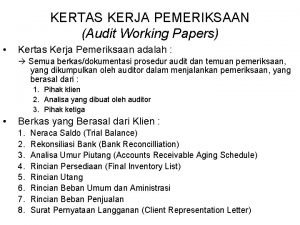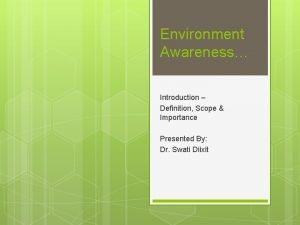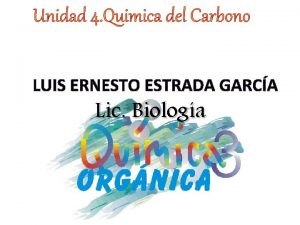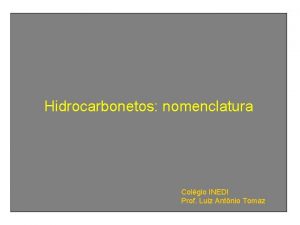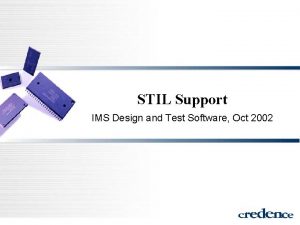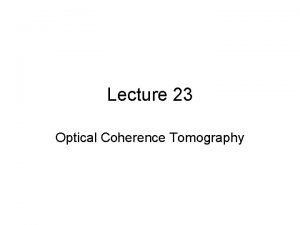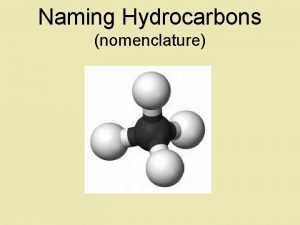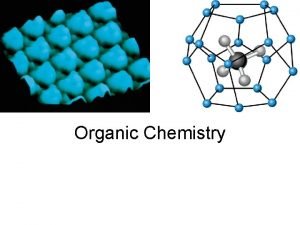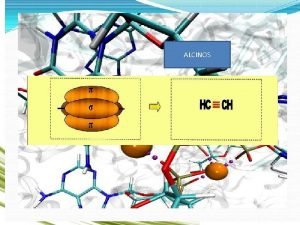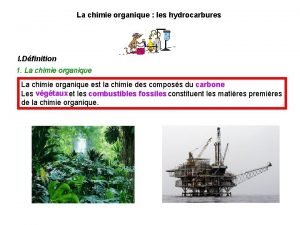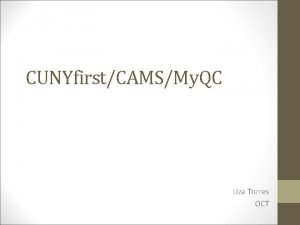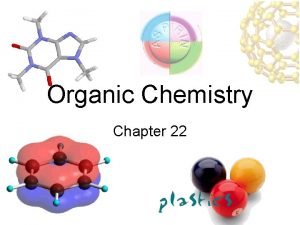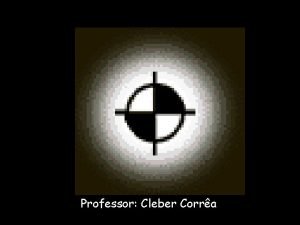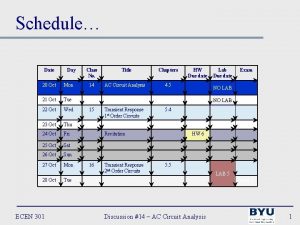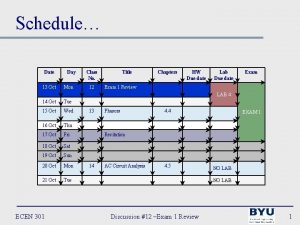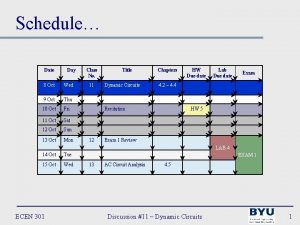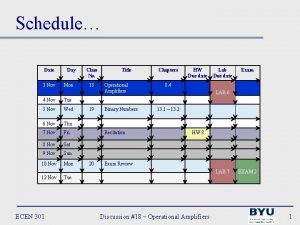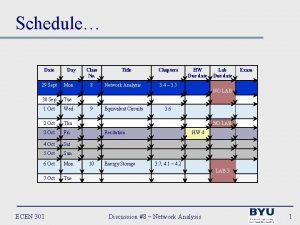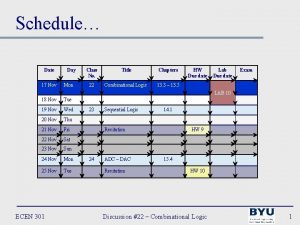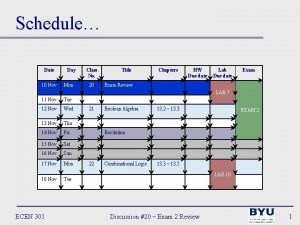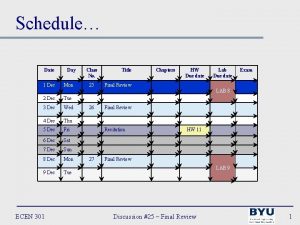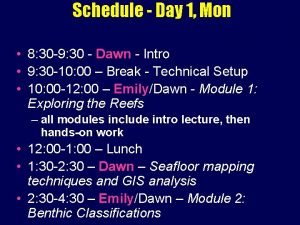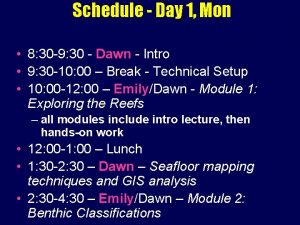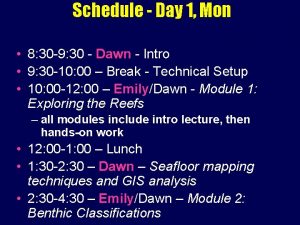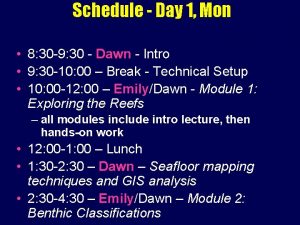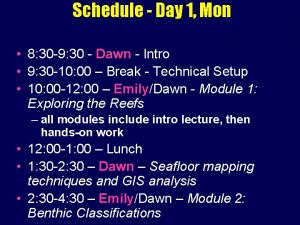Schedule Date Day 6 Oct Mon 7 Oct

























































- Slides: 57

Schedule… Date Day 6 Oct Mon 7 Oct Tue 8 Oct Wed 9 Oct Thu 10 Oct Fri 11 Oct Sat 12 Oct Sun 13 Oct Mon 14 Oct Tue Class No. 10 Title Energy Storage Chapters HW Due date 3. 7, 4. 1 Lab Due date NO LAB 11 Dynamic Circuits Recitation 12 4. 2 – 4. 4 HW 4 Exam 1 Review LAB 4 ECEN 301 Exam Discussion #10 – Energy Storage EXAM 1 1

Energy Moro. 7: 48 48 Wherefore, my beloved brethren, pray unto the Father with all the energy of heart, that ye may be filled with this love, which he hath bestowed upon all who are true followers of his Son, Jesus Christ; that ye may become the sons of God; that when he shall appear we shall be like him, for we shall see him as he is; that we may have this hope; that we may be purified even as he is pure. Amen. ECEN 301 Discussion #10 – Energy Storage 2

Lecture 10 – Energy Storage Maximum Power Transfer Capacitors Inductors ECEN 301 Discussion #10 – Energy Storage 3

Maximum Power Transfer u. Equivalent circuit representations are important in power transfer analysis RT i + v. T + – v Load – u. Ideally all power from source is absorbed by the load ÙBut some power will be absorbed by internal circuits (represented by RT) ECEN 301 Discussion #10 – Energy Storage 4

Maximum Power Transfer u. Efficiently transferring power from source to load means that internal resistances (RT) must be minimized Ùi. e. for a given RL we want RT as small as possible! RT v. T + – i. L RL u. For a given RT there is a specific RL that will maximize power transfer to the load ECEN 301 Discussion #10 – Energy Storage 5

Maximum Power Transfer u. Consider the power (PL) absorbed by the load RT v. T ECEN 301 + – i. L RL Discussion #10 – Energy Storage 6

Maximum Power Transfer u. Consider the power (PL) absorbed by the load RT v. T + – BUT i. L RL Therefore ECEN 301 Discussion #10 – Energy Storage 7

Maximum Power Transfer u. The maximum power transfer can be found by calculating d. PL/d. RL = 0 RT v. T + – OR i. L RL OR NB: assumes RT is fixed and RL is variable ECEN 301 Discussion #10 – Energy Storage 8

Maximum Power Transfer When RL < RT: PL is lowered since v. L goes down When RL > RT: PL is lowered since less current (i. L) flows To transfer maximum power to the load, the source and load resistors must be matched (i. e. RT = RL). Power is attenuated as RL departs from RT ECEN 301 Discussion #10 – Energy Storage 9

Maximum Power Transfer Maximum power theorem: maximum power is delivered by a source (represented by its Thévenin equivalent circuit) is attained when the load (RL) is equal to the Thévenin resistance RT RT v. T + – i. L RL NB: Substitute (RT = RL) to get PLMax ECEN 301 Discussion #10 – Energy Storage 10

Maximum Power Transfer Efficiency of power transfer (η): the ratio of the power delivered to the load (Pout), to the power supplied by the source (Pin) NB: Pout = PL ECEN 301 Discussion #10 – Energy Storage 11

Maximum Power Transfer Efficiency of power transfer (η): the ratio of the power delivered to the load (Pout), to the power supplied by the source (Pin) RT v. T + – ECEN 301 i. L RL Discussion #10 – Energy Storage 12

Maximum Power Transfer Efficiency of power transfer (η): the ratio of the power delivered to the load (Pout), to the power supplied by the source (Pin) RT v. T + – i. L RL NB: Substitute (RT = RL) to get Pin. Max ECEN 301 Discussion #10 – Energy Storage 13

Maximum Power Transfer Efficiency of power transfer (η): the ratio of the power delivered to the load (Pout), to the power supplied by the source (Pin) RT v. T + – ECEN 301 i. L RL Discussion #10 – Energy Storage In other words, at best, only 50% efficiency can be achieved 14

Maximum Power Transfer u. Example 1: Find the maximum power delivered to RL Ùvs = 18 V, R 1 = 3Ω, R 2 = 6Ω, R 3 = 2Ω R 1 vs + – ECEN 301 R 3 R 2 RL Discussion #10 – Energy Storage 15

Maximum Power Transfer u. Example 1: Find the maximum power delivered to RL Ùvs = 18 V, R 1 = 3Ω, R 2 = 6Ω, R 3 = 2Ω 1. Find Thévenin equivalent circuit RT v. T + – ECEN 301 RL Discussion #10 – Energy Storage 16

Maximum Power Transfer u. Example 1: Find the maximum power delivered to RL Ùvs = 18 V, R 1 = 3Ω, R 2 = 6Ω, R 3 = 2Ω 1. 2. 3. RT v. T + – ECEN 301 Find Thévenin equivalent circuit Set RL = RT Calculate PLMax RL Discussion #10 – Energy Storage 17

Dynamic Energy Storage Elements Capacitor and Inductor ECEN 301 Discussion #10 – Energy Storage 18

Storage Elements u. To this point, circuits have consisted of either: ÙDC Sources (active element, provide energy) ÙResistors (passive element, absorb energy) u. Some passive (non-source) elements can store energy ÙCapacitors – store voltage ÙInductors – store current + C – +C– + L – Capacitor symbols ECEN 301 Discussion #10 – Energy Storage + L – Inductor symbols 19

Ideal Capacitor u. A capacitor (C) is composed of: Ù 2 parallel conducting plates • cross-sectional area A ÙSeparated distance d by either: + • Air • Dielectric (insulating) material A d Dielectric (or air) C – Capacitance ε – relative permittivity (dielectric constant) ECEN 301 – NB: the parallel plates do not touch – thus under DC current a capacitor acts like an open circuit Discussion #10 – Energy Storage 20

Ideal Capacitor Capacitance: a measure of the ability to store energy in the form of separated charge (or an electric field) The charge q+ on one plate is equal to the charge q– on the other plate + + ++ + – –– ––– Farad (F): unit of capacitance. 1 farad = 1 coulomb/volt (C/V) ECEN 301 Discussion #10 – Energy Storage 21

Ideal Capacitor u No current can flow through a capacitor if the voltage across it is constant (i. e. connected to a DC source) u BUT when a DC source is applied to a capacitor, there is an initial circuit current as the capacitor plates are charged (‘charging’ the capacitor) i Charging the capacitor: a current flows as electrons leave one plate to accumulate on the other. This occurs until the voltage across the capacitor = source voltage ECEN 301 vs + – Discussion #10 – Energy Storage ++ + + – – – 22

Ideal Capacitor u Capacitor with an AC source: since AC sources periodically reverse voltage directions, the capacitor plates will change charge polarity accordingly Ù With each polarity change, the capacitor goes through a ‘charging’ state, thus current continuously flows Ù Just as with a DC source, no electrons cross between the plates Ù Just as with a DC source, voltage across a capacitor cannot change instantaneously i vs(t) + – ECEN 301 i ++ + + – – – vs(t) – + Discussion #10 – Energy Storage –– – – + + +++ 23

Ideal Capacitor ui – v characteristic for an ideal capacitor Differentiate both sides BUT OR ECEN 301 Discussion #10 – Energy Storage 24

Ideal Capacitor ui – v characteristic for an ideal capacitor NB: Assumes we know the value of the capacitor from time (τ = -∞) until time (τ = t) Instead Initial condition Initial time (often t 0 = 0) ECEN 301 Discussion #10 – Energy Storage 25

Ideal Capacitor u Example 2: calculate the current through the capacitor C = 0. 1μF with the voltage as shown: v(t) = 5(1 -e-t/10 -6) ECEN 301 Discussion #10 – Energy Storage 26

Ideal Capacitor u Example 2: calculate the current through the capacitor C = 0. 1μF with the voltage as shown: v(t) = 5(1 -e-t/10 -6) ECEN 301 Discussion #10 – Energy Storage 27

Ideal Capacitor u Example 2: calculate the current through the capacitor C = 0. 1μF with the voltage as shown: v(t) = 5(1 -e-t/10 -6) NB: the capacitor’s current jumps ‘instantaneously’ to 0. 5 A. The ability of a capacitor’s current to change instantaneously is an important property of capacitors ECEN 301 Discussion #10 – Energy Storage 28

Ideal Capacitor u. Example 3: find the voltage v(t) for a capacitor C = 0. 5 F with the current as shown and v(0) = 0 ECEN 301 Discussion #10 – Energy Storage 29

Ideal Capacitor u. Example 3: find the voltage v(t) for a capacitor C = 0. 5 F with the current as shown and v(0) = 0 ECEN 301 Discussion #10 – Energy Storage 30

Ideal Capacitor u. Example 3: find the voltage v(t) for a capacitor C = 0. 5 F with the current as shown and v(0) = 0 ECEN 301 Discussion #10 – Energy Storage 31

Ideal Capacitor u. Example 3: find the voltage v(t) for a capacitor C = 0. 5 F with the current as shown and v(0) = 0 ECEN 301 Discussion #10 – Energy Storage 32

Ideal Capacitor u. Example 3: find the voltage v(t) for a capacitor C = 0. 5 F with the current as shown and v(0) = 0 NB: The final value of the capacitor voltage after the current source has stopped charging the capacitor depends on two things: 1. The initial capacitor voltage 2. The history of the capacitor current ECEN 301 Discussion #10 – Energy Storage 33

Series Capacitors u. Capacitor Series Rule: two or more circuit elements are said to be in series if the current from one element exclusively flows into the next element. ÙCapacitors in series add the same way resistors in parallel add C 1 C 2 C 3 Cn ∙∙∙ CN ∙∙∙ CEQ ECEN 301 Discussion #10 – Energy Storage 34

Parallel Capacitors u. Parallel Rule: two or more circuit elements are said to be in parallel if the elements share the same terminals ÙCapacitors in parallel add the same way resistors in series add C 1 ECEN 301 C 2 C 3 Cn CN Discussion #10 – Energy Storage CEQ 35

Parallel and Series Capacitors u. Example 4: determine the equivalent capacitance CEQ ÙC 1 = 2 m. F, C 2 = 2 m. F, C 3 = 1 m. F, C 4 = 1/3 m. F, C 5 = 1/3 m. F, C 6 = 1/3 m. F C 1 C 4 C 3 C 2 ECEN 301 C 6 C 5 Discussion #10 – Energy Storage 36

Parallel and Series Capacitors u. Example 4: determine the equivalent capacitance CEQ ÙC 1 = 2 m. F, C 2 = 2 m. F, C 3 = 1 m. F, C 4 = 1/3 m. F, C 5 = 1/3 m. F, C 6 = 1/3 m. F C 1 C 4 C 3 C 2 ECEN 301 C 6 C 5 Discussion #10 – Energy Storage 37

Parallel and Series Capacitors u. Example 4: determine the equivalent capacitance CEQ ÙC 1 = 2 m. F, C 2 = 2 m. F, C 3 = 1 m. F, C 4 = 1/3 m. F, C 5 = 1/3 m. F, C 6 = 1/3 m. F C 1 C 3 CEQ 1 C 2 ECEN 301 Discussion #10 – Energy Storage 38

Parallel and Series Capacitors u. Example 4: determine the equivalent capacitance CEQ ÙC 1 = 2 m. F, C 2 = 2 m. F, C 3 = 1 m. F, C 4 = 1/3 m. F, C 5 = 1/3 m. F, C 6 = 1/3 m. F C 1 CEQ 2 C 2 ECEN 301 Discussion #10 – Energy Storage 39

Parallel and Series Capacitors u. Example 4: determine the equivalent capacitance CEQ ÙC 1 = 2 m. F, C 2 = 2 m. F, C 3 = 1 m. F, C 4 = 1/3 m. F, C 5 = 1/3 m. F, C 6 = 1/3 m. F CEQ ECEN 301 Discussion #10 – Energy Storage 40

Energy Storage in Capacitors Capacitor energy WC(t): can be found by taking the integral of power ÙInstantaneous power PC = iv Since the capacitor is uncharged at t = -∞, v(- ∞) = 0, thus: ECEN 301 Discussion #10 – Energy Storage 41

Ideal Inductor u. Inductors are made by winding a coil of wire around a core ÙThe core can be an insulator or ferromagnetic material + N turns l – L – Inductance μ – relative permeability • Cross-sectional area A • Diameter d ECEN 301 Discussion #10 – Energy Storage 42

Ideal Inductor Inductance: a measure of the ability of a device to store energy in the form of a magnetic field Ideally the resistance through an inductor is zero (i. e. no voltage drop), thus an inductor acts like a short circuit in the presence of a DC source. i BUT there is an initial voltage across the inductor as the current builds up (much like ‘charging’ with capacitors) Henry (H): unit of inductance. 1 henry = 1 volt-second/ampere (V-s/A) ECEN 301 Discussion #10 – Energy Storage 43

Ideal Inductor u Inductor with an AC source: since AC sources periodically reverse current directions, the current flow through the inductor also changes Ù With each current direction change, the current through the inductor must ‘build up’, thus there is a continual voltage drop across the inductor Ù Just as with a DC source, current across an inductor cannot change instantaneously i i vs(t) + – ECEN 301 vs(t) – + Discussion #10 – Energy Storage 44

Ideal Inductor u. I – v characteristic for an ideal inductor NB: note the duality between inductors and capacitors ECEN 301 Discussion #10 – Energy Storage 45

Ideal Inductor ui – v characteristic for an ideal inductor NB: Assumes we know the value of the inductor from time (τ = -∞) until time (τ = t) Instead Initial condition Initial time (often t 0 = 0) ECEN 301 Discussion #10 – Energy Storage 46

Ideal Inductor u. Example 5: find the voltage across an inductor L = 0. 1 H when the current is: i(t) = 20 t e-2 t ECEN 301 Discussion #10 – Energy Storage 47

Ideal Inductor u. Example 5: find the voltage across an inductor L = 0. 1 H when the current is: i(t) = 20 t e-2 t ECEN 301 Discussion #10 – Energy Storage 48

Ideal Inductor u. Example 5: find the voltage across an inductor L = 0. 1 H when the current is: i(t) = 20 t e-2 t NB: the inductor’s voltage jumps ‘instantaneously’ to 2 V. The ability of an inductor’s voltage to change instantaneously is an important property of inductors ECEN 301 Discussion #10 – Energy Storage 49

Series Inductors u. Series Rule: two or more circuit elements are said to be in series if the current from one element exclusively flows into the next element. ÙInductors in series add the same way resistors in series add L 1 L 2 L 3 Ln ∙∙∙ LN ∙∙∙ LEQ ECEN 301 Discussion #10 – Energy Storage 50

Parallel Inductors u. Parallel Rule: two or more circuit elements are said to be in parallel if the elements share the same terminals ÙInductors in parallel add the same way resistors in parallel add L 1 ECEN 301 L 2 L 3 Ln LN Discussion #10 – Energy Storage LEQ 51

Energy Storage in Capacitors Capacitor energy WL(t): can be found by taking the integral of power ÙInstantaneous power PL = iv Since the inductor is uncharged at t = -∞, i(- ∞) = 0, thus: ECEN 301 Discussion #10 – Energy Storage 52

Energy Storage in Capacitors u Example 6: calculate the power and energy stored in a 0. 1 -H inductor when: Ù i = 20 t e-2 t A (i = 0 for t < 0) Ù V = 2 e-2 t (1 - 2 t)V (for t >= 0) ECEN 301 Discussion #10 – Energy Storage 53

Energy Storage in Capacitors u Example 6: calculate the power and energy stored in a 0. 1 -H inductor when: Ù i = 20 t e-2 t A (i = 0 for t < 0) Ù V = 2 e-2 t (1 - 2 t)V (for t >= 0) ECEN 301 Discussion #10 – Energy Storage 54

Energy Storage in Capacitors u Example 6: calculate the power and energy stored in a 0. 1 -H inductor when: Ù i = 20 t e-2 t A (i = 0 for t < 0) Ù V = 2 e-2 t (1 - 2 t)V (for t >= 0) ECEN 301 Discussion #10 – Energy Storage 55

Ideal Capacitors and Inductors Passive sign convention Capacitors +C– + L – i i Voltage Current Power ECEN 301 Discussion #10 – Energy Storage 56

Ideal Capacitors and Inductors Capacitors An instantaneous change is not permitted in: Current Voltage Will permit an instantaneous change in: Voltage Current With DC source element acts as a: Short Circuit Open Circuit Energy ECEN 301 Discussion #10 – Energy Storage 57
 Day 1 day 2 day 3 day 4
Day 1 day 2 day 3 day 4 Day 1 day 2 day 817
Day 1 day 2 day 817 Record date ex dividend date
Record date ex dividend date Ex date vs record date
Ex date vs record date Quel est la date de ton anniversaire
Quel est la date de ton anniversaire Quelle est la date de votre anniversaire
Quelle est la date de votre anniversaire Contoh top schedule dan supporting schedule
Contoh top schedule dan supporting schedule New day and date always begins in the _________ of idl.
New day and date always begins in the _________ of idl. What is environment
What is environment Que ma vie soit une fleur
Que ma vie soit une fleur Tactique futsal
Tactique futsal Growing day by day
Growing day by day I live for jesus day after day
I live for jesus day after day Day to day maintenance
Day to day maintenance Observation of seed germination day by day
Observation of seed germination day by day One day casting crowns
One day casting crowns As your room gets messier day by day, entropy is
As your room gets messier day by day, entropy is Conclusion of seed germination
Conclusion of seed germination Schoolmax login
Schoolmax login Day one day one noodle ss2
Day one day one noodle ss2 Timeline for acts i-iii
Timeline for acts i-iii Tomorrow i don't know
Tomorrow i don't know Role of transpiration
Role of transpiration Haiku and
Haiku and Sunset on october 31st
Sunset on october 31st 5 characteristics of homologous series
5 characteristics of homologous series Jhlt. 2019 oct; 38(10): 1015-1066
Jhlt. 2019 oct; 38(10): 1015-1066 Eteno
Eteno Oct 3 1993
Oct 3 1993 Meth eth prop but mnemonic
Meth eth prop but mnemonic Oct vizsgálat
Oct vizsgálat Oct spectralis
Oct spectralis Hex hept oct non dec
Hex hept oct non dec Met et prop but pent hex hept oct non dec
Met et prop but pent hex hept oct non dec But-1-ene
But-1-ene Jhlt. 2019 oct; 38(10): 1015-1066
Jhlt. 2019 oct; 38(10): 1015-1066 Stil oct
Stil oct Principle of oct
Principle of oct Hydrocarbons
Hydrocarbons But pent hex hept
But pent hex hept Visante oct
Visante oct Brief life sketch of mahatma gandhi
Brief life sketch of mahatma gandhi Jhlt. 2019 oct; 38(10): 1015-1066
Jhlt. 2019 oct; 38(10): 1015-1066 Prop but pent hex hept oct
Prop but pent hex hept oct 3butino
3butino Proppent
Proppent Meth eth but prop
Meth eth but prop Met et prop but pent hex hept oct non dec
Met et prop but pent hex hept oct non dec Jhlt. 2019 oct; 38(10): 1015-1066
Jhlt. 2019 oct; 38(10): 1015-1066 Cunyfirst
Cunyfirst Systemy liczbowe
Systemy liczbowe Scleral lens oct
Scleral lens oct Saturated bond
Saturated bond Propil
Propil Met et prop but pent hex hept oct non dec undec
Met et prop but pent hex hept oct non dec undec Who is absent today
Who is absent today Sanghiyang kahulugan
Sanghiyang kahulugan Ready to eat tcs food must be date marked
Ready to eat tcs food must be date marked






